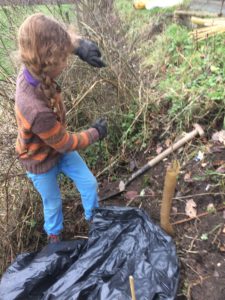As our young people find themselves increasingly screen-bound in their education, it is more important than ever to get outside, be active and explore. Beyond the silicon chip, the real world is still out there!
I have been very lucky during the latest covid-19 lockdown to have acquired a forestry apprentice. She is eight (nearly nine!) and will build her understanding and skills from woodland management through to timber properties and uses, including making items from wood gleaned during her management work.
She is working in our newest plantation, where the trees are her age! There is plenty of work in a young woodland for small hands. We started by identifying different species and understanding that some will be favoured in our woodland management to reach their timber potential. Being slower to establish and find good form, we started focusing on oak. She has used secateurs to carefully remove strong forks by cutting branches at the collar. Birch however has grown fast and straight, already closing a canopy over the oak in places. My new apprentice, armed with a pruning saw, puts that right, using directional felling cuts to safely fell the birch into a gap.

Planting a hawthorn hedge
More recently, she has had the chance to start at the very beginning. She joined us in a hedge planting job for a neighbour. Keeping the roots of her hedge plants well wrapped while she made a deep slot in the ground to bury them in the strip of ground screefed to remove grass competition.
She will no doubt keep me informed of their progress through the year as she passes to visit me for her forestry apprentice sessions.
If you are interested in helping a young person you know engage with woodland, there is support from the Royal Forestry Society’s Junior Forester Award. It is suitable for ages 4-14 and the syllabus is fully adaptable to your child, skills, confidence and the outdoor resources available to you.
Let’s get our future foresters skilled up!
